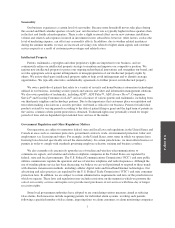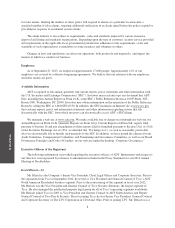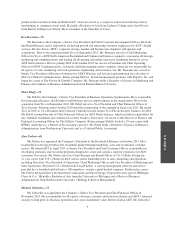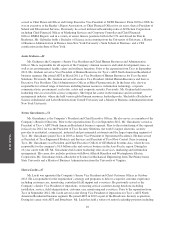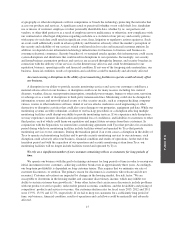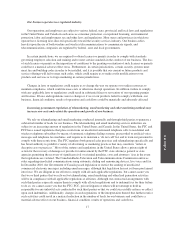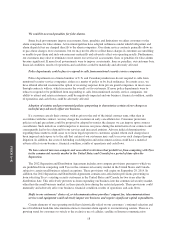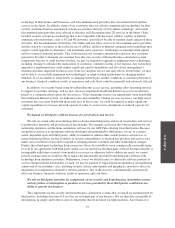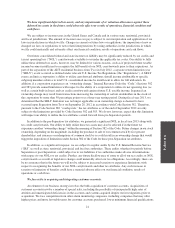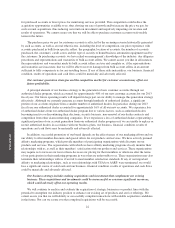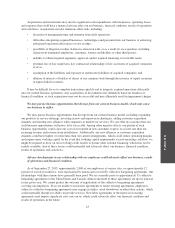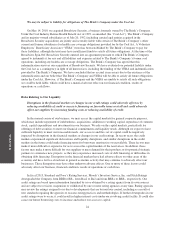ADT 2013 Annual Report Download - page 79
Download and view the complete annual report
Please find page 79 of the 2013 ADT annual report below. You can navigate through the pages in the report by either clicking on the pages listed below, or by using the keyword search tool below to find specific information within the annual report.
FORM 10-K
cryptography or other developments will not compromise or breach the technology protecting the networks that
access our products and services. A significant actual or perceived (whether or not valid) theft, loss, fraudulent
use or misuse of customer, employee or other personally identifiable data, whether by us, our partners and
vendors, or other third parties or as a result of employee error or malfeasance or otherwise, non-compliance with
our contractual or other legal obligations regarding such data or a violation of our privacy and security policies
with respect to such data could result in significant costs, fines, litigation or regulatory actions against us. Such
an event could additionally result in adverse publicity and therefore adversely affect the market’s perception of
the security and reliability of our services, which could result in lost sales and increased customer attrition. In
addition, we depend on our information technology infrastructure for business-to-business and business-to-
consumer electronic commerce. Security breaches of, or sustained attacks against, this infrastructure could create
system disruptions and shutdowns that could result in disruptions to our operations. Increasingly, our security
and home/business automation products and services are accessed through the Internet, and security breaches in
connection with the delivery of our services via the Internet may affect us and could be detrimental to our
reputation, business, operating results and financial condition. If any one of the foregoing risks materializes, our
business, financial condition, results of operations and cash flows could be materially and adversely affected.
An event causing a disruption in the ability of our monitoring facilities to operate could adversely affect
our business.
A disruption in our ability to provide security monitoring services and serve our customers could have a
material adverse effect on our business. A disruption could occur for many reasons, including fire, natural
disasters, weather, disease, transportation interruption, extended power outages, human or other error, terrorism
or sabotage or as a result of disruptions to third-party transmission lines. Monitoring could also be disrupted by
information systems and network-related events or cyber security attacks, such as computer hacking, computer
viruses, worms or other malicious software, denial of service attacks, malicious social engineering or other
destructive or disruptive activities that could also cause damage to our properties, equipment and data. While our
monitoring systems are fully redundant, a failure of our back-up procedures or a disruption affecting multiple
monitoring facilities could disrupt our ability to provide monitoring services. If we experience such disruptions,
we may experience customer dissatisfaction and potential loss of confidence, and liabilities to customers or other
third parties, each of which could harm our reputation and impact future revenues from these customers. In
conjunction with the Separation, we entered into a monitoring agreement with Tyco that provides for a transition
period during which our monitoring facilities include facilities owned and operated by Tyco that provide
monitoring services to our customers. During the transition period if an event causes a disruption in the ability of
Tyco to operate such monitoring facilities and to provide security monitoring services to our customers, such
disruption could adversely affect our business, financial condition and results of operations. At the end of the
transition period and with the separation of our operations and security monitoring system from Tyco, our
monitoring facilities will no longer include facilities owned and operated by Tyco.
We rely on a significant number of our customers remaining with us as customers for long periods of
time.
We operate our business with the goal of retaining customers for long periods of time in order to recoup our
initial investment in new customers, achieving cash flow break-even in approximately three years. Accordingly,
our long-term profitability is dependent on long customer tenure. This requires that we minimize our rate of
customer disconnects, or attrition. The primary reason for disconnects is customers who relocate and do not
reconnect. Customer relocations are impacted by changes in the housing market. See risk factor “We are
susceptible to downturns in the housing market and consumer discretionary income, which may inhibit our
ability to sustain customer base growth rate.” Some other factors that can increase disconnects include problems
with our product or service quality, unfavorable general economic conditions, and the desirability and pricing of
competitors’ products and services over ours. Our customer attrition rates for fiscal years 2013, 2012 and 2011
were 13.9%, 13.5% and 12.7%, respectively. If we fail to keep our customers for a sufficiently long period of
time, our business, financial condition, results of operations and cash flows could be materially and adversely
affected.
15




